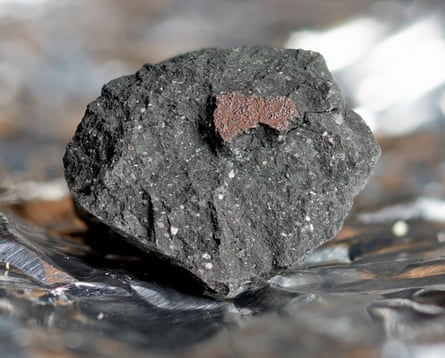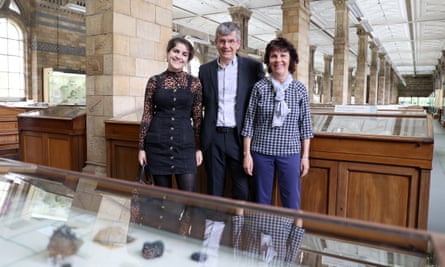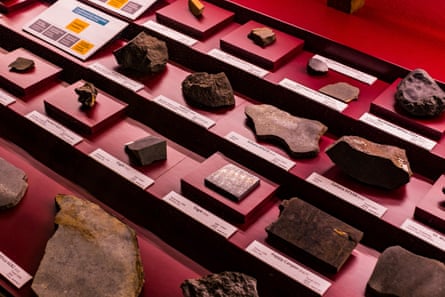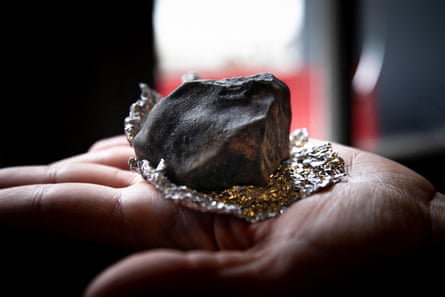At 21.54 on 28 February 2021, 16 cameras belonging to amateur sky-watching network UKMON picked up a bright shape headed towards Earth. Pictures show a long white line, which was visible for eight minutes, a glowing globule of light against the dark sky. “For me it’s like fishing,” said Richard Kacerek, one of the founders of UKMON. “You cast your line and then you wait. There are days when you catch nothing but there are days when you catch a really, really big fish and it’s so exciting.” The fireball of February 2021 was such a fish: a lump of flaming extraterrestrial rock travelling at a speed of about 8.4 miles a second – 15 times the speed of a rifle bullet – and headed for the Cotswolds market town of Winchcombe.
Meteorites are rocks from space that have entered our atmosphere. Most were once part of asteroids – the rocky, airless remnants left over from the formation of our solar system 4.6bn years ago. Almost all of them are what collectors call “finds”, meaning that the stone has been discovered by searching the ground, having fallen earlier – in most cases several thousand years earlier. A “fall”, a meteorite that is seen in flight and then recovered, is very, very rare. Worldwide, typically only about 10 such rocks are picked up each year. Before 2021, the last reported UK fall was a rock the size of a cricket ball that landed in a hedge in Glatton in Cambridgeshire in May 1991.
With its woods, heaths, moors and arable farm land, and with so many other terrestrial rocks and pebbles to confuse things, most of the UK is terrible meteorite-hunting territory. Even so, with enough flight data you can attempt to calculate a meteorite’s trajectory, to try to figure out where it has landed.
On 1 March, the morning after the fireball, Ashley King, a planetary scientist at the Natural History Museum (NHM) and lead of the UK Fireball Alliance (UKFall), began scanning the data from the camera networks. UKFall brings together the different hobbyist camera networks and the professional scientists who want to find and study the meteorites. The scientists studied a map of the Cotswolds and drew an oval shape covering a 280km2 area where parts of a meteorite might have landed. Now the race was on to try to recover the rocks.
As soon as a meteorite enters the Earth’s atmosphere it begins to change, thanks to the effects of oxygen, wind, rain or any other contaminating material. This is why recently fallen meteorites are especially prized. Meteorite collectors term them “fresh”. The weather in the Cotswolds on 28 February and 1 March was clear and dry but it was imperative to reach the meteorite – if it had survived the journey – as soon as possible.
Because the UK was in lockdown, the teams from the NHM, the University of Glasgow and other institutions couldn’t immediately travel to Winchcombe. Usually they would try to keep a search area to themselves for three or four days but now, as King and his colleagues anxiously scanned the weather forecasts, they took the decision to ask the public for help. Once the meteor speed slows to below 3km a second it stops shining and enters what is called “dark flight”, when it is no longer observable. To work out where it landed you have to make various assumptions about what the rock is made of, what shape it is and what the wind will have done to it.

The map of where it could have fallen was released. King spent the day talking to journalists and making announcements on the radio. To minimise contamination, King issued the following instructions to the public: “If you find something that might be a meteorite take a photograph of it in situ; record the location; only handle it wearing gloves; put it into a sealable plastic bag or some aluminium foil. Email us!”
The less the meteorite was altered by its stay on Earth, the greater the scientific value would be. Meteorites – because of their great age and because, compared with Earth rocks, they are relatively pristine – provide a window back in time through which we might glimpse the processes that formed and shaped the solar system, the moons, the planets and our own world. Most rocks on Earth have been subjected to plate tectonics – the constant destruction and recycling of our Earth’s crust – and to weathering on the surface. Any information about the very early Earth has been destroyed. If we want to read those earliest pages of Earth’s history, meteorites from asteroids are the oldest objects available for study. Without them we cannot begin to answer the questions: where did we come from? How did we begin?
With a population of 5,000, Winchcombe is a pretty town of honeycomb-coloured limestone and timber-framed buildings. The Wilcock family home is a neat 1960s detached house on a quiet cul-de-sac on the outskirts of town. Early in the morning of 1 March, Cathryn Wilcock, a retired primary school teacher, opened the curtains of her living room and noticed a pile of dark lumps and powder at the edge of her driveway. It looked as though someone had upended an old barbecue.
The Winchcombe meteorite had probably travelled more than 100m miles to reach our planet. Had it landed just a few metres to the left it would have fallen into a thick privet hedge and probably never been discovered. Had it landed a few metres closer to the road, Cathryn would have assumed it was rubbish churned up by a passing car and swept it away. Instead, her husband, Rob, went out to investigate.
Rob immediately recognised that something strange had occurred. He got together some rubber gloves, old yoghurt pots and plastic bags and went outside to pick up the stones.
The NHM and other institutions that deal with meteorites are used to fielding inquiries from people who think they’ve found a space rock. Among the scientific meteorite community, such rocks have their own name: meteorwrongs. Randy L Korotev, a scientist at Washington University in St Louis, Missouri, has a webpage devoted to them. “I have examined thousands of photos that people have sent to me over the past 20-plus years. Probably for less than 1 in 1,000 photos have I thought: ‘Yes, that might be a meteorite,’” he has written, with some exasperation. Slag is a particular issue. A glassy byproduct of smelting ores to retrieve metal, it looks nothing like the local rocks around it. It looks a bit like what your idea of a meteorite might be: dark and gnarly, something forged with fire. As a meteorite enters the Earth’s atmosphere, slowing down, it begins to rapidly cool, and its molten surface forms a dark, glassy coating called a fusion crust. Unlike a meteorite, slag has large vesicles – holes caused by gas bubbles when the rock was originally cooling – and no fusion crust.
Another challenge is that when people see a fire in the sky, they tend to assume that it’s very close to them. In reality, because the meteorite is high in the sky and therefore visible across vast swathes of land, it may be very far away. With the Winchcombe meteorite, King had photographs of rocks sent in from places as distant as Scotland. The NHM scientists were swamped with replies. So when, around 4pm on the Monday, King viewed an email with a photograph of someone’s driveway, he was initially suspicious. The photograph showed some dark black lumps surrounded by dark black powder. It was the sort of splat shape you might expect if something fell to the ground from a great height.
“I have to admit that I wasn’t absolutely convinced at first,” King said. “That splat shape … it was a little bit too perfect. You do get people who will fake things. It’s a weird thing to do but it happens,” he said. What were the chances of the meteorite landing so neatly and conveniently in front of someone’s house? (According to the Harvard astrophysicist Avi Loeb: “Statistically, you have to wait for a billion years before your home will be hit by a meteorite.”)
But fake or not, King wanted to get his hands on the potential meteorites as quickly as possible. In addition to the weather, there was another reason to hurry. With news of the meteorite all over the internet, professional meteorite hunters would be alerted to the scene. Here, the Covid lockdown was in some ways a piece of good fortune. “Otherwise we could have been overrun with big meteorite hunters from abroad,” King told me. These are the sorts of people who can jump on a plane at a moment’s notice to get to the site of a suspected fall.

On 2 March, Richard Greenwood, a scientist at the Open University, sat down at his desk to see what King had sent him. Rob Wilcock’s picture was the first image he opened. “To be honest it was like one of those moments when your legs start going wobbly because I saw this thing … and I just thought – that is a meteorite,” he told the BBC. “It was instantaneous.”
By 3 March, King was negotiating with the NHM and the government to get permission to travel to the Cotswolds. Greenwood, who lives near Winchcombe, set off as soon as he could. When he arrived at the Wilcocks’ house, Rob came out holding a plastic bag. “It was the second wobbly moment of the day. I looked inside and I could not believe it,” Greenwood said. Not only was there a meteorite in the bag, it looked to be a very, very unusual one: a carbonaceous chondrite. Comprising only about 4% of all meteorite falls, these are among the most primitive and pristine of space rocks. They are also rich in water and organic material. Some scientists believe that carbonaceous chondrites were responsible for delivering the first water to our planet. Without meteorites, so the theory goes, there would be no rivers or oceans, lakes or streams. Some also believe that the organic material they contain – amino acids and other prebiotic molecules – could have combined with simple molecules, such as ammonia and carbon dioxide, to create the first proteins and RNA molecules: the blueprint to build and operate every living entity on Earth.
“There is just literally the country’s most interesting meteorite in 400 years and I’m the first person who knew that’s what it was,” Greenwood told reporters. “It was very hard to contain the emotions.”
News began to ripple through the meteorite community. Minutes after Greenwood met Wilcock, Luke Daly from the University of Glasgow posted in a group chat: “Holy [––] just got off the phone with Ashley [King], and Richard [Greenwood] met with one of the black rock finders and reckons it a CM chondrite! Ashley is on his way now. Don’t spread this!”
Having travelled for nearly four hours on eerily empty tubes and trains from south London, King arrived in Winchcombe. Because of lockdown rules, the Wilcocks set up a small table on the patio to look at his finds.
“Watching their faces light up, I started to realise for the first time that this was something really special,” Rob Wilcock told me. The enormity of what had taken place was beginning to sink in. Two days later he looked on as some of the most important names in meteoritics crawled over his front lawn wielding tweezers. Rob had already collected further fragments and built a little protective structure around the area of the driveway where the main mass of the meteorite (the largest section) had landed. Now he was sent up a ladder to check the flat roof for material. Even tiny specks were worth collecting. Cathryn gave the scientists some old toothbrushes to help sweep up the grains. Later, the scientists cut out the square of driveway where the meteorite had landed and transported it to London. There, they attempted to recover more fragments. The tarmac itself would feature in the museum archives along with the plastic bags and Waitrose yoghurt pots that Rob had used to collect the meteorite.
In total, 319.5g of the meteorite was recovered from the Wilcocks’ property. They donated everything to the NHM, the Winchcombe Museum and the Wilson Art Gallery and Museum in Cheltenham. “It just seems to have really found the right people to fall on,” King said of the Wilcocks. “It couldn’t have been any better.”
Meanwhile King finally received the data from the dark flight model. They now had a potential strewn field: a much smaller, more searchable area where larger pieces of the meteorite could have landed and remained intact. New hunts were organised. Scientists and student volunteers spread out 2 metres apart in lines like police at a crime scene. They walked slowly over the cold fields, heads down, looking for small, black stones that had travelled to Earth from somewhere between Mars and Jupiter. It was hard going. Many possible meteorites turned out to be lumps of sheep droppings.

Meteorite hunter and collector Luther Jackson describes this sort of hunt as a mixture of science and detective work. For instance, strewn fields typically have what hunters call a big and a small end. The big end is where larger pieces fall first. The small end is where the smaller pieces, which are lighter and therefore travel further, will land. Within the strewn field Jackson will look for likely places to hunt: “Anywhere with a very uniform surface, such as a football pitch or tennis court, is good.” He makes a point of talking to everyone he meets. “You never know what information will come up, or offers [from people] to let you search their land.” Often he brings a stick with a magnet attached to test rocks. (Not all meteorites are magnetic – those from the moon, for example, are not – but most are, being rich in iron. Some scientists discourage the use of magnets because they can erase any record of the magnetic field of the meteorite’s parent body.) It’s slow, back-breaking work.
In Winchcombe the scientists’ efforts were finally rewarded when Mira Ihasz, a volunteer with the University of Glasgow search team, found a stone weighing 152g – the largest intact piece. The main mass recovered from the Wilcocks’ driveway was not “intact”, having fractured into millimetre- to centimetre-sized pieces and powder.
If the British countryside – with its rain, mud, vegetation, sheep’s droppings and so on – is far from ideal meteorite-hunting territory, the Sahara is its opposite. Dark meteorites stand out against the sand, and even very old falls are often well preserved in the dry desert climate, meaning there are an estimated tens of thousands of years’ worth of fallen meteorites waiting to be discovered.
Towards the end of the 20th century, these facts – combined with a favourable legal and geopolitical situation and the presence of many skilled local hunters, often members of nomadic groups – turned Morocco into one of the world’s greatest exporters of space rocks. The UK has recorded a mere 23 falls and finds. The number of officially recognised Moroccan meteorites exceeds a thousand – though this is described by scientists as “a gross underestimate”. Many meteorites collected in Morocco are not precisely documented and so not attributed specifically to that country. The majority are only submitted for official recognition when they are perceived to have sufficient commercial value.
At an auction in 2022 a bean-sized 1.7g fragment from the Winchcombe meteorite went for £9,256, 120 times the value of its weight in gold. In a general way, meteorites can cost anything from a few pounds to hundreds of thousands, their value largely determined by the collecting community.
In recent years, as meteorites have grown in popularity, prices have shot up – about which the dealers had mixed feelings. Higher prices are obviously good for the seller but many people complained to me particularly about the rocketing prices commanded by really fresh falls, taking interesting new meteorites out of the reach of the general collecting community.
In Morocco, news of a new meteorite fall is liable to bring hundreds of people to the most inhospitable desert locations. Many will be inexperienced and ill-prepared – sometimes with tragic results. “In 2017, there was a fall in July when it was extremely hot and the military told us that two people died because they didn’t have enough water, and they didn’t know where they were,” Hasnaa Chennaoui Aoudjehane, a professor at the Hassan II University of Casablanca, told me.
In 1980s Morocco, when Chennaoui was studying for a geology degree, the subject was considered an exclusively male pursuit. Today she is one of the country’s leading meteorite authorities, though she is often still the only woman on trips into the Sahara to hunt for meteorites. Back in 2011, she received a call from the Meteoritical Society, the group that maintains the official register of all known meteorites, asking her to travel to a remote part of southern Morocco near the border with Algeria. There were rumours that a black rock had fallen from the sky. Some reports claimed that it was an incredibly rare meteorite type. Chennaoui accepted the mission.
In addition to the risk of getting fatally lost in an often seemingly featureless landscape, dangers include (but are not limited to) scorpions, snakes, shifting sand dunes and buried landmines. “You have to go to the field with people that have a good knowledge of the area. And you have to trust them. I cannot go into the desert with someone that I’ve never travelled with before,” Chennaoui said.

To reach the site of the 2011 fall required a five-hour, 45-mile drive along a rocky desert track. “We were in the middle of nowhere. Absolutely nowhere. And when we arrived at the site we found hundreds and hundreds of people. Men, women, children. People had heard that there were rocks coming from the sky and that they had value.”
Though she personally found only tiny fragments of the meteorite that together weighed much less than 1g, Chennaoui conducted interviews, documented locations and saw stones found by other meteorite hunters. The stones looked as though they’d been dipped in black vinyl. “I have never seen anything so nice in my life; the fusion crust is so shiny, and very black,” she said in an interview for Live Science. Altogether 7kg of the meteorite were collected. On 17 January 2012, the Meteoritical Society formally added the meteorite to their register. It was named Tissint after the village nearest to the fall site. Most exciting of all was where this meteorite was found to have originated: the planet Mars.
It is stupendously rare to witness a fall from Mars. Fewer than 0.3% of meteorites in collections are from the red planet. And like Winchcombe, Tissint is distinguished by having fallen in a dry area and been picked up soon afterwards with minimal contamination. Chennaoui was the lead author on the first Tissint report, working with 20 researchers from different countries. She was even able to see evidence of weathering that had occurred on Mars’s surface. It was almost as if it had just been blasted off the surface of Mars.
Meteorite hunting can be a frustrating pastime. You might have access to camera footage and sophisticated weather data, or live next to an optimum meteorite hunting site, but you can’t influence when a space rock will decide to drop in. At a meteorite show in France I met Thierry Monter, a French meteorite dealer and graphic designer. On his stand was a semicircle of tarmac that on closer inspection turned out to be part of a tennis court. In February 2023 Monter was abroad, on holiday with his girlfriend, when he heard about a new meteorite fall back in France. “It was just horrible,” he told me. “The worst vacation of my life! I was waiting for years for a meteorite fall and then it happened in France and I wasn’t there! I was checking the news every day and watching as pieces were found.”

As soon as he arrived home, Monter set out for the fall site in Saint-Pierre-le-Viger in Normandy. He was seven days late and knew that most of the decent spots would already have been picked over but decided to try his luck on a local tennis court. (A good place to hunt because there was a large flat surface with no grass or bushes.) “I saw something that looked like gravel but there was a sparkle on it!’ He’d found his first meteorite. Then he found some more, and then some more. In total he collected about 400g in many pieces, some of which he was selling at the show. Because it had smashed apart on impact you could see the dark black fusion crust on the outside and a creamy interior studded with rust-coloured spots. He was also selling the very, very small impact crater that the meteorite had made on the tennis court. “I am not rich. Quite the contrary in fact. And if I earn some big money I could turn being a meteorite dealer into my job,” he said.
For Monter, the fact that the meteorite had landed in France of all countries made it even more significant. When, out of all the places on the planet a meteorite could land, it lands in our place, the vast otherness of space comes into direct contact with our earthbound everyday lives. Recently a bright fireball was sighted over the English Midlands. The chair of a greenhouse factory in Cresswell, a village in the middle of the search area, was interviewed by the press. “We were just amazed that such a thing could happen in our little corner of Staffordshire,” he said.
In Winchcombe, the Wilcocks have installed a small metal plaque on their driveway to commemorate the place their meteorite landed. Wherever they fall, these remarkable, unlikely stones seem to demand from us an act of witness. This incredible thing; it happened here. A wooden post in Essex commemorates the 1923 Ashdon meteorite; a brick pillar in Yorkshire the 1795 Wold Cottage fall; a sculpture in Alsace the 1492 Ensisheim event. Such monuments seek to fix in place and time something transient. They speak of a desire to recognise that here, in this place, on this specific spot, the fabric of the everyday world was briefly pulled aside.
Adapted from The Meteorites: Encounters with Outer Space and Deep Time by Helen Gordon, published by Profile

 3 months ago
52
3 months ago
52













































